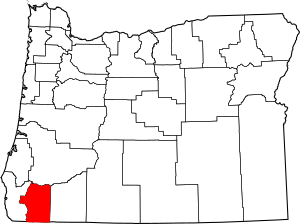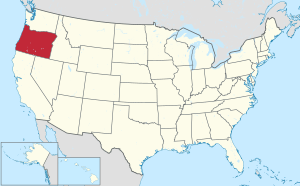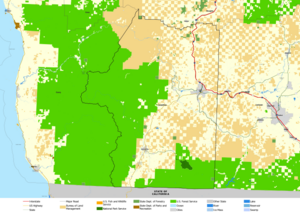Josephine County, Oregon facts for kids
Quick facts for kids
Josephine County
|
|
|---|---|
|
From clockwise: Josephine County Courthouse, the "It's the Climate" banner in downtown Grants Pass, Miller's Chapel in the Oregon Caves National Monument, the Rogue River from Hellgate Canyon, Illinois River Forks State Park
|
|

Location within the U.S. state of Oregon
|
|
 Oregon's location within the U.S. |
|
| Country | |
| State | |
| Founded | January 22, 1856 |
| Named for | Virginia “Josephine” Rollins |
| Seat | Grants Pass |
| Largest city | Grants Pass |
| Area | |
| • Total | 1,642 sq mi (4,250 km2) |
| • Land | 1,640 sq mi (4,200 km2) |
| • Water | 2.2 sq mi (6 km2) 0.1%% |
| Population
(2020)
|
|
| • Total | 88,090 |
| • Estimate
(2023)
|
87,821 |
| • Density | 50/sq mi (20/km2) |
| Time zone | UTC−8 (Pacific) |
| • Summer (DST) | UTC−7 (PDT) |
| Congressional district | 2nd |
Josephine County is one of the 36 counties in the U.S. state of Oregon. As of the 2020 census, the population was 88,090. The county seat is Grants Pass. The county is named after Virginia Josephine Rollins (1834–1912), a settler who was the first white woman to live in the county's boundaries. Josephine County comprises the Grants Pass, OR Metropolitan Statistical Area, which is included in the Medford-Grants Pass, OR Combined Statistical Area.
Contents
History
The discovery of rich placers at Sailor Diggings (later known as Waldo) in 1852 and the resulting gold rush brought the first settlers to this region. Several U.S. Army forts were maintained in the county and many engagements during the Rogue River Indian War (1855–1858) took place within its boundaries. In 1851, a group of prospectors moved to the Illinois Valley and made the first discovery of gold in Southern Oregon. In this group was Floyd Rollins and his daughter, Josephine Rollins Ort, after whom the county is named. On January 22, 1856, a bill was passed by the territorial legislature separating what is now Josephine County from Jackson County. The bill made Sailor Diggings (later known as Waldo) the county seat. It was the nineteenth, and last, county created before statehood.
In 1885, the county seat was relocated to Kerby, where the county's first jail was built. In 1885, the Oregon Legislature adjusted the boundary between Jackson and Josephine County, making Grants Pass a part of Josephine County. This was done primarily to have a railroad head within the new county. In June 1886 the voters of Josephine County considered three towns for the new county seat. These were: Kerby, Wilderville and Grants Pass. Grants Pass won with 116 votes out of the 716 ballots cast.
In the 1920s, the county improved its tourist facilities. In 1922, the Grants Pass Cavemen booster club was created, where members dressed in furs and wielded clubs at events. Events organized by the club ranged from simply blocking traffic, to bidding on the construction of the San Francisco–Oakland Bay Bridge (at a cost of 23,756,000 deer hides), to initiating politicians into their club including Mark Hatfield and Thomas E. Dewey during his 1948 presidential campaign. Russian newspapers used images of the Grants Pass Cavemen to show 'how the rich "cavort" in America.' Although bridges had been built across the Rogue River by the 1920s, ferries were still used to convey people and cars across. The first Grants Pass bridge was destroyed by a flood in 1890. The first newspaper in Josephine County was the Argus, which began publication on March 13, 1885. It lasted only a few months, but the Grants Pass Courier began three weeks later. The Illinois Valley News published in Cave Junction started in 1937 and is still a paper of record in Josephine County publishing every Wednesday. In 1897, the first legal hanging took place in Josephine County. Lemson W. Melson confessed to the murder of Charles Perry while the noose was around his neck.
Ethnic history
Although several tribes of Native Americans lived in the area from which Josephine County was created, most of their members had been moved to the reservation at Grand Ronde by the end of the Rogue River Indian War. Soon afterwards all Indians in southwest Oregon, with the exception of a few small bands, were moved to the Coast reservation (later known as the Siletz Reservation).
Josephine County was also the home to a large Chinese population. Most had come to the area to work gold claims purchased from whites no longer interested in working them. Even though they could not own land, they had to pay a tax to mine gold, and were usually relegated to inferior claims.
Geography
According to the United States Census Bureau, the county has a total
area of 1,642 square miles (4,250 km2), of which 1,640 square miles (4,200 km2) is land and 2.2 square miles (5.7 km2) (0.1%) is water.
Adjacent counties
- Douglas County (north)
- Jackson County (east)
- Siskiyou County, California (south)
- Del Norte County, California (southwest)
- Curry County (west)
National protected areas
- Oregon Caves National Monument
- Rogue River-Siskiyou National Forest (part)
Demographics
| Historical population | |||
|---|---|---|---|
| Census | Pop. | %± | |
| 1860 | 1,623 | — | |
| 1870 | 1,204 | −25.8% | |
| 1880 | 2,485 | 106.4% | |
| 1890 | 4,878 | 96.3% | |
| 1900 | 7,517 | 54.1% | |
| 1910 | 9,567 | 27.3% | |
| 1920 | 7,655 | −20.0% | |
| 1930 | 11,498 | 50.2% | |
| 1940 | 16,301 | 41.8% | |
| 1950 | 26,542 | 62.8% | |
| 1960 | 29,917 | 12.7% | |
| 1970 | 35,746 | 19.5% | |
| 1980 | 58,855 | 64.6% | |
| 1990 | 62,649 | 6.4% | |
| 2000 | 75,726 | 20.9% | |
| 2010 | 82,713 | 9.2% | |
| 2020 | 88,090 | 6.5% | |
| 2023 (est.) | 87,821 | 6.2% | |
| U.S. Decennial Census 1790–1960 1900–1990 1990–2000 2010–2020 |
|||
2010 census
As of the 2010 census, there were 82,713 people, 34,646 households, and 22,498 families residing in the county. The population density was 50.4 inhabitants per square mile (19.5/km2). There were 38,001 housing units at an average density of 23.2 units per square mile (9.0 units/km2). The racial makeup of the county was 92.4% white, 1.4% American Indian, 0.8% Asian, 0.4% black or African American, 0.2% Pacific islander, 1.5% from other races, and 3.2% from two or more races. Those of Hispanic or Latino origin made up 6.3% of the population. In terms of ancestry, 26.3% were German, 15.6% were Irish, 15.5% were English, 5.5% were Italian, and 5.5% were American.
Of the 34,646 households, 25.5% had children under the age of 18 living with them, 49.2% were married couples living together, 11.0% had a female householder with no husband present, 35.1% were non-families, and 28.3% of all households were made up of individuals. The average household size was 2.34 and the average family size was 2.82. The median age was 47.3 years.
The median income for a household in the county was $38,035 and the median income for a family was $48,180. Males had a median income of $38,675 versus $27,926 for females. The per capita income for the county was $21,539. About 13.5% of families and 17.8% of the population were below the poverty line, including 27.3% of those under age 18 and 9.1% of those age 65 or over.
Communities
Cities
- Althouse (former)
- Cave Junction
- Grants Pass (county seat)
Census-designated places
Unincorporated communities
- Bridgeview
- Dryden
- Galice
- Harbeck (former)
- Holland
- Hugo
- Leland
- Murphy
- Placer
- Pleasant Valley
- Rand
- Sunny Valley
- Three Pines
- Wilderville
- Wolf Creek
- Wonder
Former communities
Economy
Most of the commercial activity during the territorial period centered on gold mining and the supply of provisions to miners. Miners had been active in the Rogue and Illinois valleys since 1851. By the late 1850s, however, gold mining was beginning to decline and population dwindled as well. In 1859, gold was discovered along the Fraser River in British Columbia and numerous people left Josephine County to search for valuable claims there.
Josephine County shares the Rogue Valley and Applegate Valley wine appellations with Jackson County. The U.S. government owns the majority of the land within the county boundaries, with the Bureau of Land Management owning 28% of the lands within the county boundaries, most of which are Oregon and California Railroad lands, and the Forest Service owning 39%.
Grants Pass is now the departure point for most Rogue River scenic waterway guided fishing and boat trips, one of the destinations being Hellgate canyon. The Illinois River, one of the Rogue's tributaries, has also been designated a scenic waterway.
Transportation
Initially, freight was brought into Josephine County by pack train. As the trails improved, freight wagons were used. Stage coaches were the primary mode of transportation until 1914, when auto stages took over, halving the time from Crescent City to Grants Pass from 24 to 12 hours.
In 1883, the Oregon and California Railroad reached Grants Pass, in Jackson County at the time. The first through train from Portland, Oregon arrived in Grants Pass on Christmas Eve of 1883. Due to delays in completing a railroad through the Siskiyou Mountains, the first train from California didn't arrive until 1887. Josephine County was served by the Oregon and California Railroad. In 1923, commercial flight in Josephine County began when airplanes began taking off from the American Legion Air Field. The airfield has since been replaced by an industrial park.
Libraries
In May 2007, all libraries in Josephine County were closed due to lack of county government funding. In September 2007, committed community members formed Josephine Community Libraries, Inc., a nonprofit, nongovernmental organization. On December 20, 2008, the Grants Pass library opened again. On September 5, 2009, the Illinois Valley library was reopened. On November 7, 2009, the Williams library was reopened. With the reopening of the Wolf Creek branch on December 19, 2009, all four library branches in Josephine County were restored. Josephine Community Libraries, Inc. (JCLI) is a nonprofit, nongovernmental library system serving the 82,000 residents of Josephine County. In May 2017, citizens placed a measure on the ballot to permanently fund the libraries, which passed by 53 percent of the vote. For 10 years, the libraries were supported by generous donations and the heroic contributions of more than 360 volunteers annually. Now, JCLI is committed to a seamless transition of library services to the newly formed library district and is working to support the district effort until the anticipated transition is completed in 2018.
See also
 In Spanish: Condado de Josephine para niños
In Spanish: Condado de Josephine para niños







